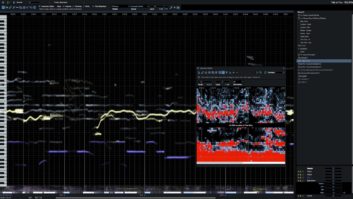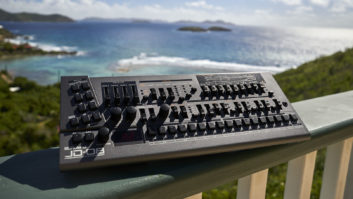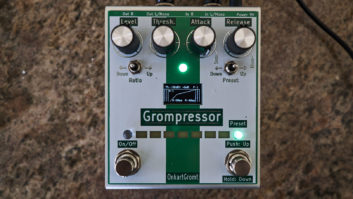
| MIX VERDICT: MIXLAND VAC ATTACK |
| THE TAKEAWAY: “The thing that impressed me the most about Vac Attack—on everything I used it on—was the tone it imparted.” |
| COMPANY: Plugin Alliance • www.plugin-alliance.com PRICE: $249 PROS: • Sounds astonishingly like high-end vacuum-tube hardware. • Excellent dynamics control. CONS: • Nothing significant. |
New York, NY (March 28, 2024)—The name Vac Attack screams “vacuum tubes,” but it’s not the only nod to this plug-in’s nonlinearity; even the UI, which looks like a photo of a well-worn vintage processor, chipped paint and all, promises lavish tone. And well it should—inspired by the discontinued Inward Connections Vac Rac TSL-4 opto-electronic limiter, Vac Attack’s sound heaps luscious cream on everything it touches.
Basic operation is simple: Turn up the rotary Reduction control to add more compression depth, and raise the Gain knob to boost makeup gain. (Activating the Gain Link function makes the makeup gain automatically compensate for applied gain reduction.) As is typical with opto-electronic compressor/limiters, there are no controls for adjusting attack and release times; timing is automatic and program dependent, resulting in compression ratios 3.52:1 and higher. Use the Knee knob to smoothly tame or outright slam your track above threshold, and the Link switch for like effect on both channels of a stereo instance. A Mix knob delivers parallel compression, and VU-style meters show gain-reduction amounts.
A generous complement of rotary sidechain-EQ controls influences how the limiter variously reacts to bass, midrange and treble frequencies. For example, raise the highpass filter’s corner frequency—adjustable from 0 to 450 Hz—to reduce pumping on bass-heavy tracks. To prevent squashing scintillating cymbal crashes, lower the lowpass filter’s frequency—adjustable from 24 kHz down to 750 Hz. You can also home in more selectively on any frequency from 50 Hz to 10 kHz by adjusting the Freq knob, making the limiter more reactive to your chosen frequency when the associated Gain knob is set higher than its noon position, and less when it’s set lower.
Low- and high-shelving EQ controls—their alternate switch settings mysteriously labeled “J” and “E” for internal reasons—let you boost or cut below either 52 or 230 Hz and above 4.4 or 10 kHz in the audio path, after compression. Cranking the THD knob progressively adds harmonic saturation post-compression, lending girth and creaminess to your track.
Vac Attack lets you link all controls in left and right channels of a stereo instance, toggle between A and B workspaces, activate oversampling (up to 16x rate), undo and redo your control tweaks, save and recall presets, and adjust the UI’s size from 75 to 150 percent.

UNDER ATTACK!
Using a hard knee for Vac Attack smoothed levels on a rock lead vocal track nicely, and lightly bumping up the THD control made the male singer sound richer and fatter. Even on vocal tracks that needed no further compression (they’d been leveled enough while recording), I loved boosting Vac Attack’s 10 kHz shelving EQ and THD—the Reduction control set to zero to avoid compression—to bless the track with a velvety sheen.
Hard-knee limiting, low-shelving boost and a generous serving of THD was just what the doctor ordered to treat a jumpy and somewhat thin-sounding bass guitar track, leveling it and making it sound fat and growly. Nosediving the plug-in’s 10 kHz shelving EQ tamed the clackety-clack of fret noises without dulling the instrument’s presence in the mix.
Vac Attack also sounded terrific on hard-panned, double-tracked electric guitars playing power chords. Parallel compression and added THD augmented the inherent wall-of-sound onslaught, while cutting the plug-in’s low-shelving EQ -7 dB at 52 Hz removed rumble that was masking the bass guitar.
Dear Reality Exoverb Stereo Reverb Plug-In — A Mix Real-World Review
I usually program my own plug-in presets from scratch, but Vac Attack includes a factory preset called JRay Drum Vibe that sounds too awesome on drum room mics to go unused. The preset employs heavy compression with a very hard knee, but what really makes the preset rock is frequencies below 271 Hz in the sidechain are substantially rolled off, allowing the kick drum to breathe. Post-compression shelving boost at 52 Hz augments the effect, and the THD knob is cranked big-time to put massive hair on the mics.
I only had to roll off the high end a little (using the plug-in’s high-shelving EQ) to tame the ear-piercing cymbals on my hard-hitting Southern rock tracks. The end result sounded way more explosive than I expected a virtual opto-compressor could. (I typically reach for a faster-acting FET limiter to slam room mics.) Not only did Vac Attack rocket the room ambience, the drum kit sounded physically three times bigger.
The thing that impressed me the most about Vac Attack—on everything I used it on—was the tone it imparted. Mixland did a fantastic job emulating lush tube circuitry with forgiving headroom, allowing you to push tracks hard without breaking up. Vac Attack is a monster!







